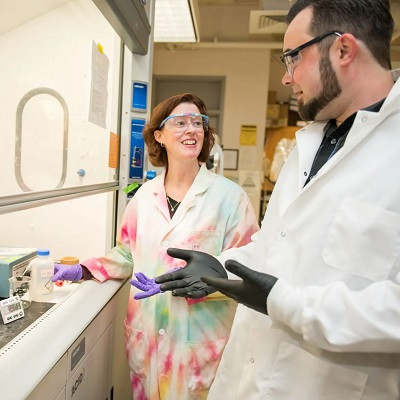
2021-11-29
Visited : 2470
When a person experiences a trauma that leads to significant bleeding, the first few minutes are critical. It’s important that they receive intravenous medication quickly to control the bleeding, but delivering the medication at the right rate can prove challenging. Slower infusions can cause fewer negative reactions, but the medication might not work fast enough, particularly in the case of a serious trauma.
Four UMBC researchers have developed a unique way of modifying the surfaces of nanoparticles within these life-saving medications to provide infusions that can be delivered more quickly, but with a reduced risk of negative reactions. Infusion reactions can cause a range of symptoms, such as rashes and inflammatory responses. This can include anaphylaxis, a life-threatening respiratory failure. Up until this point, the seriousness of these reactions has limited the use of promising nanomedicines, and reducing the likelihood of adverse reactions could be game-changing.
The core of the issue
In a paper recently published in Nano Letters, Erin Lavik, professor of chemical, biochemical, and environmental engineering; Chuck Bieberich, professor of biological sciences; Nuzhat Maisha, Ph.D. ‘21, chemical engineering; and Michael Rubenstein, M.S. ‘14, Ph.D. ‘22, biological sciences, discuss their novel approach to the research. They focused on the core material of the nanoparticles delivered to patients.
“We found that using a polyurethane core reduced the markers associated with infusion reactions,” explains Lavik, who is also the associate dean for research and faculty development in UMBC’s College of Engineering and Information Technology.
Currently, 7% of people experience infusion reactions, the authors note in their paper. “These reactions limit the treatments available in a substantial portion of patients,” they explain.
“We, like most of the field, have spent a lot of time trying to modify the surfaces of nanoparticles to modulate the reaction,” says Lavik. She shares that while that approach does help to a degree, going a step further by changing the core material appears to have a greater impact.
The research conducted by Lavik, Bieberich, and their colleagues lays the groundwork for future testing of preclinical models using nanocapsules to stop internal bleeding. Lavik explains that collaboration was an important element of this work, especially being able to conduct the research in UMBC’s Interdisciplinary Life Sciences Building.
Read the original article on University of Maryland, Baltimore County (UMBC).